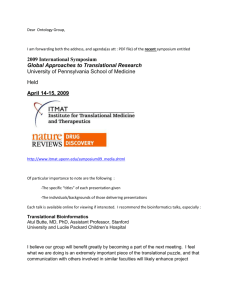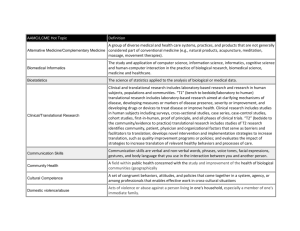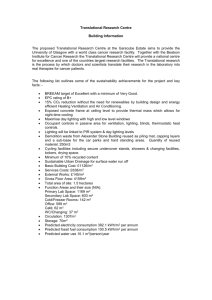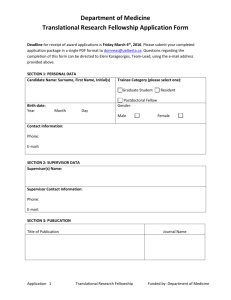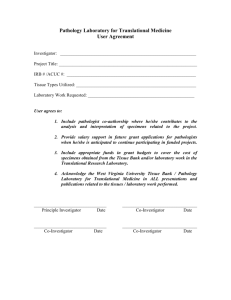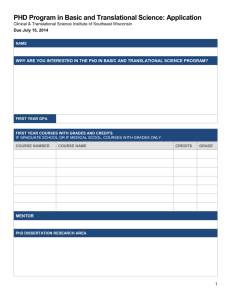System
advertisement
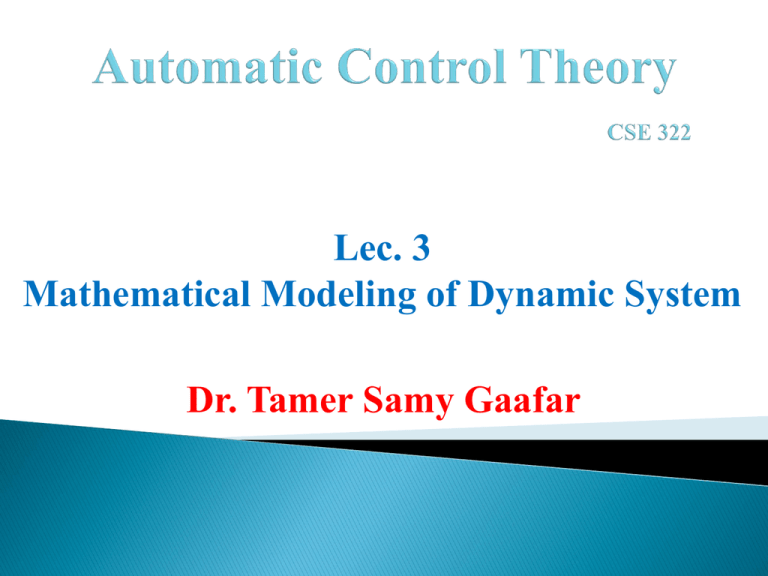
Lec. 3 Mathematical Modeling of Dynamic System Dr. Tamer Samy Gaafar www.tsgaafar.faculty.zu.edu.eg Email: tsgaafar@yahoo.com Quiz (10 mins) Find the transfer function of the following block diagrams H4 R(s) Y (s ) G1 G3 G2 G4 H3 H2 H1 3 Solution: 1. Moving pickoff point A behind block G4 I H4 R(s) Y (s ) G1 G3 G2 H3 H2 H3 G4 H2 G4 A G4 B 1 G4 1 G4 H1 4 2. Eliminate loop I and Simplify R(s) G2G3G4 1 G3G4 H 4 G1 II Y (s ) B H3 G4 H2 G4 III H1 II feedback G2G3G4 1 G3G4 H 4 G2G3 H 3 III Not feedback H 2 G4 H 1 G4 5 3. Eliminate loop II & IIII R(s) G1G2G3G4 1 G3G4 H 4 G2G3 H 3 Y (s ) H 2 G4 H 1 G4 G1G2G3G4 Y (s) R( s ) 1 G2G3 H 3 G3G4 H 4 G1G2G3 H 2 G1G2G3G4 H1 6 • • • • Static System: If a system does not change with time, it is called a static system. The o/p depends on the i/p at the present time only Dynamic System: If a system changes with time, it is called a dynamic system. The o/p depends on the i/p at the present time and the past time. (integrator, differentiator). 7 • A system is said to be dynamic if its current output may depend on the past history as well as the present values of the input variables. • Mathematically, y( t ) [ u( ),0 t ] u : Input, t : Time Example: A moving mass y u Model: Force=Mass x Acceleration My u M System Experiment with a model of the System Experiment with actual System Mathematical Model Physical Model Analytical Solution Simulation Frequency Domain Time Domain Hybrid Domain 9 • • • A model is a simplified representation or abstraction of reality. Reality is generally too complex to copy exactly. Much of the complexity is actually irrelevant in problem solving. 10 A set of mathematical equations (e.g., differential equs.) that describes the input-output behavior of a system. What is a model used for? • Simulation • Prediction/Forecasting • Prognostics/Diagnostics • Design/Performance Evaluation • Control System Design 1. Electrical Systems Basic Elements of Electrical Systems • The time domain expression relating voltage and current for the resistor is given by Ohm’s law i.e. v R (t ) iR (t )R • The Laplace transform of the above equation is VR ( s ) I R ( s ) R Basic Elements of Electrical Systems • The time domain expression relating voltage and current for the Capacitor is given as: 1 vc (t ) ic (t )dt C • The Laplace transform of the above equation (assuming there is no charge stored in the capacitor) is 1 Vc ( s ) Ic (s) Cs Basic Elements of Electrical Systems • The time domain expression relating voltage and current for the inductor is given as: diL (t ) v L (t ) L dt • The Laplace transform of the above equation (assuming there is no energy stored in inductor) is VL ( s ) LsI L ( s ) Componen t Resistor Symbol V-I Relation I-V Relation v R (t ) iR (t )R v R (t ) iR (t ) R Capacitor dvc (t ) 1 vc (t ) ic (t )dt ic (t ) C C dt Inductor diL (t ) v L (t ) L dt 1 iL (t ) v L (t )dt L 16 The two-port network shown in the following figure has vi(t) as the input voltage and vo(t) as the output voltage. Find the transfer function Vo(s)/Vi(s) of the network. vi( t) i(t) C vo(t) 1 v i ( t ) i( t ) R i( t )dt C 1 vo ( t ) i( t )dt C 17 1 1 vo ( t ) v i ( t ) i( t ) R i( t )dt i( t )dt C C Taking Laplace transform of both equations, considering initial conditions to zero. 1 Vi ( s ) I ( s ) R I (s) Cs 1 Vo ( s ) I (s) Cs Re-arrange both equations as: Vi ( s ) I ( s )( R 1 ) Cs CsVo ( s ) I ( s ) 18 1 Vi ( s ) I ( s )( R ) CsVo ( s ) I ( s ) Cs Substitute I(s) in equation on left 1 Vi ( s ) CsVo ( s )( R ) Cs Vo ( s ) Vi ( s ) 1 1 Cs( R ) Cs Vo ( s ) 1 Vi ( s ) 1 RCs 19 Vo ( s ) 1 Vi ( s ) 1 RCs The system has one pole at 1 RCs 0 s 1 RC 20 Design an Electrical system that would place a pole at -3 if added to another system. Vo ( s ) 1 Vi ( s ) 1 RCs vi( t) C i(t) System has one pole at v2(t) 1 s RC Therefore, 1 3 RC if R 1 M and C 333 pF 21 iR(t) IR(S) + + Transformation vR(t) - ZR = R VR(S) - 22 iL(t) IL(S) + vL(t) - ZL=LS + VL(S) LiL(0) - 23 ic(t) Ic(S) + vc(t) - ZC(S)=1/CS + Vc(S) - 24 Consider following arrangement, equivalent transform impedance. ZT Z R Z L Z C 1 Z T R Ls Cs find out L C R 25 1 1 1 1 ZT Z R Z L ZC 1 1 1 1 1 ZT R Ls Cs L C R 26 2. Mechanical Systems Mechanical Systems • Part-I: Translational Mechanical System • Part-II: Rotational Mechanical System • Part-III: Mechanical Linkages 28 Translational ◦ Linear Motion Rotational ◦ Rotational Motion 29 Basic Elements of Translational Mechanical Systems i) ii) iii) Translational Spring Translational Mass Translational Damper 31 A translational spring is a mechanical element that can be deformed by an external force such that the deformation is directly proportional to the force applied to it. i) Translational Spring Circuit Symbols Translational Spring 32 If F is the applied force x1 x2 Then x1 is the deformation if x2 0 F Or ( x1 x 2 ) The equation of motion is given as is the deformation. F F k ( x1 x2 ) Where k is stiffness of spring expressed in N/m 33 Translational Mass • Translational Mass inertia element. is an ii) Translational Mass • A mechanical system without mass does not exist. • If a force F is applied to a mass and it is displaced to x meters then the relation b/w force and displacements is given by Newton’s law. F M x x(t ) F (t ) M 34 Translational Damper • When the viscosity or drag is not negligible in a system, we often model them with the damping force. • All the materials exhibit the property of damping to some extent. iii) Translational Damper • If damping in the system is not enough then extra elements (e.g. Dashpot) are added to increase damping. 35 Common Uses of Dashpots Door Stoppers Bridge Suspension Vehicle Suspension Flyover Suspension 36 Translational Damper b F bx b F b( x1 x2 ) • Where b is damping coefficient (N/ms-1). 37 Example-1: Consider a simple horizontal spring-mass system on a frictionless surface, as shown in figure below. mx kx or mx kx 0 38 Consider the following system (friction is negligible) k x M F • Free Body Diagram fk M fM F • Where f k and f M are force applied by the spring and inertial force respectively. 39 fk M fM F F fk fM • Then the differential equation of the system is: F Mx kx • Taking the Laplace Transform of both sides and ignoring initial conditions we get F ( s ) Ms 2 X ( s ) kX( s ) 40 Example-2 F ( s ) Ms 2 X ( s ) kX( s ) • The transfer function of the system is X (s) 1 F(s) Ms 2 k • if M 1000 kg k 2000 Nm 1 X (s) 0.001 2 F(s) s 2 41 Example-2 X (s) 0.001 2 F(s) s 2 • The pole-zero map of the system is Pole-Zero Map 40 30 Imaginary Axis 20 10 0 -10 -20 -30 -40 -1 -0.5 0 Real Axis 0.5 1 42 Consider the following system x2 x1 k B F M • Mechanical Network x1 F ↑ k x2 M B 43 • Mechanical Network x1 F At node ↑ k x2 M B x1 F k ( x1 x 2 ) At node x2 2 0 k ( x2 x1 ) Mx2 Bx 44 45 46 mxo b( x o xi ) k ( xo xi ) 0 (eq .1) mxo bxo kxo bxi kxi eq. 2 Taking Laplace Transform of the equation (2) 2 ms X o ( s ) bsX o ( s ) kXo ( s ) bsX i ( s ) kXi ( s ) X o (s) bs k X i ( s ) ms 2 bs k 47 Car Body Bogie-2 Bogie-1 Secondary Suspension Wheelsets Primary Bogie Frame Suspension 48 49

